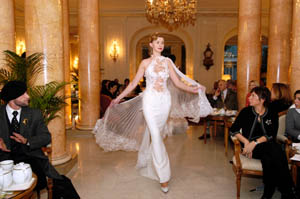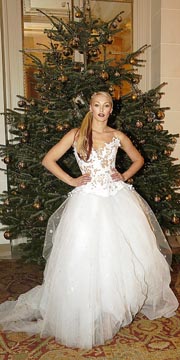|
fashion: feature
 Samedis à la mode
Samedis à la mode

Max Chaoul

Emanuel Ungaro
continued
The original motive was the commercial one of encouraging
more people into the hotel during the weekends, when guest numbers
tended to be low. After all, just as a designer needs to sell his
creations in order to survive in the market-place, so a hotelier
needs to maintain a solid client base to be able to provide consistently
excellent service. C’est logique.
But what has evolved over the seven-year history of
these samedis de la mode, is an event that is a triumph of
liberté, égalité, fraternité.
The hotel’s management have created an event that is accessible
to all, and not exclusively to its guests, nor even to those members
of the public with the kind of bank balance that might make purchase
of such gowns conceivable. From start to finish, the shows are administered
in a democratic and friendly manner, as guests are shown to armchairs
grouped around a series of small tables, carefully scattered throughout
the lounge. As orders are taken for tea (the Bristol has 15 original
varieties) or coffee, it is clear that all staff involved are proud
of the shows and delighted to share their pride and pleasure, before
and after the event, with a wider public. Management, then, is astute,
large-minded, and determined to please.
The designer’s brief is also generous, and aimed at
giving pleasure. Alongside the opportunity to showcase one’s work
and build up a client base, or, in the case of established couturiers,
to provide something special for a faithful following, designers
can use the unique space of the hotel with as much creativity as
they choose. They may invite or exclude the press; they may directly
advertise their business premises or merely arouse the interest
of prospective clients. (At the first show I attended in 2002 by
Salvatore Ferragamo, a representative went around the assembled
guests with gift bags and directions to the nearest fashion stores.)
Designers can choose their own models, but are encouraged to choose
mannequins who are unafraid of proximity to the public, who are
relaxed enough to smile, and, even, for preference, who are not
anorexically thin. This brings a refreshingly down-to-earth dimension
to an otherwise sophisticated event, as designers and their models
linger after the show and are amenable to friendly conversation
and inquiry. They speak in full sentences, smile, and, in the case
of the accomplished Alexander Docquin, the designer at the last
show I attended, they may have family with them (Alexandre had his
young daughter with him and both looked happy and relaxed). An A-grade
business card, camera, or full wallet are not required passports
to conversation. Equally, designers are not necessarily French.
On the calendar for February, Rosa Kanno fuses ‘the joy and warmth
of Brazil with the tradition and serenity of Japan’ in her collection.
And on January 24, 2009, Stella Art International chose the Hotel
Bristol to organize a fashion show around the theme of Seasons
of Russia to be presented by children from Moskva and Kyrgyzstan.
With music by Rimsky-Korsakov, Borodine and Stravinsky, this show
pushed the fashion catwalk envelope even further, by encouraging
a spirited enjoyment of other countries beyond the more abstract
cultural referencing of mainstream couture.
Of the role of the third party in this tripartite relation
between management, designer, and the public there remains only
this to say. Relieved of all pressure at the fashion high teas,
or samedis de la mode (literally, fashion Saturdays) the
public feels something they may not necessarily feel during fashion
week: namely, that they are welcome, that they are, literally, inside
the same space as the performers and neither elevated nor degraded
in relation to the level of the performance, and, finally, that
no expectation is placed on them but to enjoy themselves.
Lastly, the ubiquitous coffee culture in which many
of us live, move, and have our being, finally has a serious—and
seductively attractive—rival. Tea, anyone?
Dr Keren Chiaroni is a guest correspondent for Lucire.
Add
to Del.icio.us | Digg
it | Add
to Facebook
|
Designers can choose their own models, but are
encouraged to choose mannequins who are unafraid of proximity to
the public, who are relaxed enough to smile, and, even, for preference,
who are not anorexically thin. This brings a refreshingly down-to-earth
dimension to an otherwise sophisticated event

Max Chaoul
Notes
Details about the Thés à la mode at the Bristol
can be found on the hotel’s website, www.lebristolparis.com.
The cost of an afternoon tea, which equates also to
the entrance ticket, is 55, payable at the bar on arrival.
Reservations can be made (from within Paris) at 33
1 53-43-43-42.
Once you know the dates of your stay in Paris, check
out the calendar of events in advance so as not to miss out on a
favourite designer.
|

